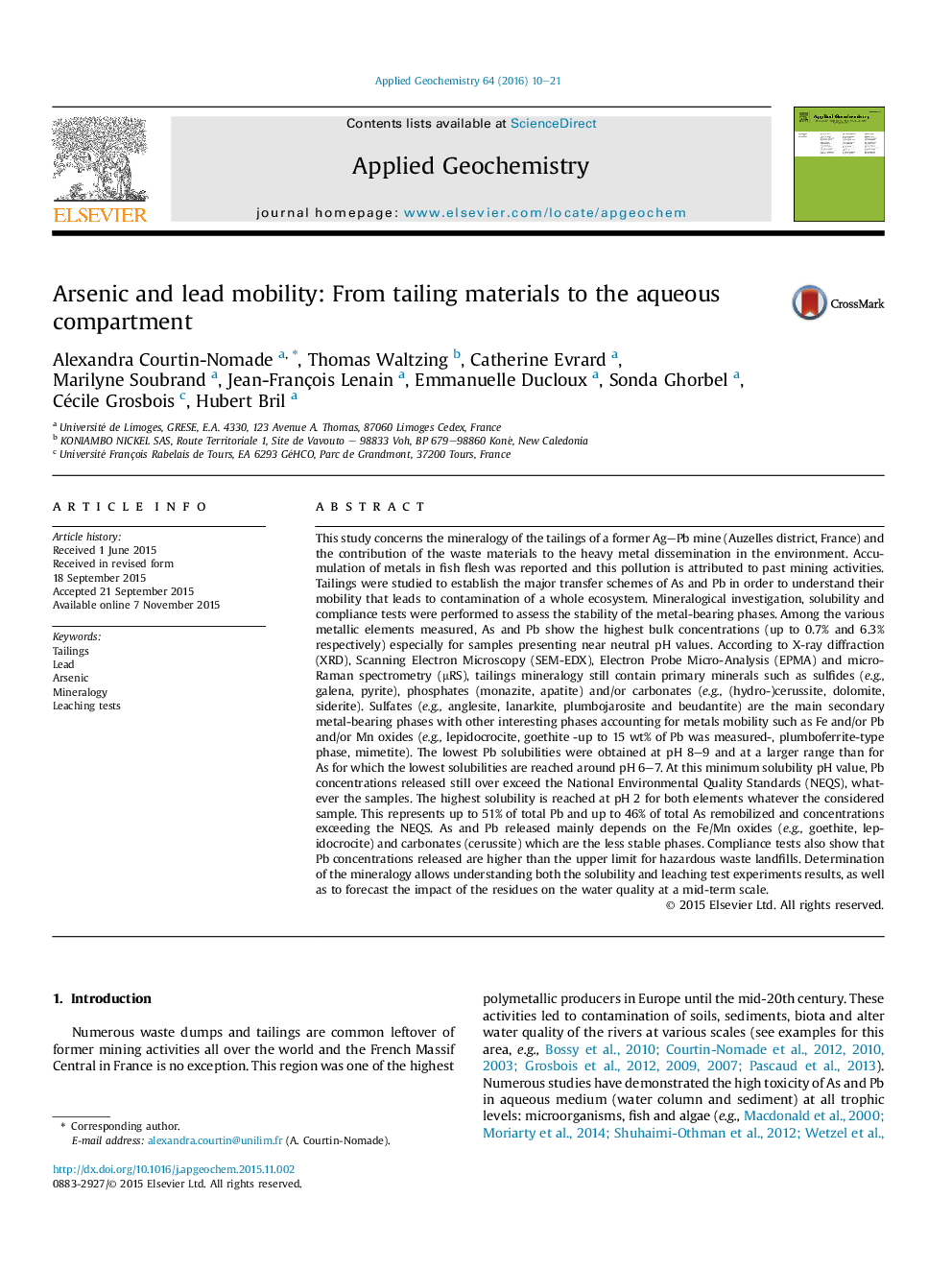| کد مقاله | کد نشریه | سال انتشار | مقاله انگلیسی | نسخه تمام متن |
|---|---|---|---|---|
| 6334852 | 1620227 | 2016 | 12 صفحه PDF | دانلود رایگان |
عنوان انگلیسی مقاله ISI
Arsenic and lead mobility: From tailing materials to the aqueous compartment
ترجمه فارسی عنوان
جابجایی آرسنیک و سرب: از مواد آجدار به محفظه آبی
دانلود مقاله + سفارش ترجمه
دانلود مقاله ISI انگلیسی
رایگان برای ایرانیان
کلمات کلیدی
تایلند، رهبری، آرسنیک، کانی شناسی، تست لیشمانده،
موضوعات مرتبط
مهندسی و علوم پایه
علوم زمین و سیارات
ژئوشیمی و پترولوژی
چکیده انگلیسی
This study concerns the mineralogy of the tailings of a former Ag-Pb mine (Auzelles district, France) and the contribution of the waste materials to the heavy metal dissemination in the environment. Accumulation of metals in fish flesh was reported and this pollution is attributed to past mining activities. Tailings were studied to establish the major transfer schemes of As and Pb in order to understand their mobility that leads to contamination of a whole ecosystem. Mineralogical investigation, solubility and compliance tests were performed to assess the stability of the metal-bearing phases. Among the various metallic elements measured, As and Pb show the highest bulk concentrations (up to 0.7% and 6.3% respectively) especially for samples presenting near neutral pH values. According to X-ray diffraction (XRD), Scanning Electron Microscopy (SEM-EDX), Electron Probe Micro-Analysis (EPMA) and micro-Raman spectrometry (μRS), tailings mineralogy still contain primary minerals such as sulfides (e.g., galena, pyrite), phosphates (monazite, apatite) and/or carbonates (e.g., (hydro-)cerussite, dolomite, siderite). Sulfates (e.g., anglesite, lanarkite, plumbojarosite and beudantite) are the main secondary metal-bearing phases with other interesting phases accounting for metals mobility such as Fe and/or Pb and/or Mn oxides (e.g., lepidocrocite, goethite -up to 15 wt% of Pb was measured-, plumboferrite-type phase, mimetite). The lowest Pb solubilities were obtained at pH 8-9 and at a larger range than for As for which the lowest solubilities are reached around pH 6-7. At this minimum solubility pH value, Pb concentrations released still over exceed the National Environmental Quality Standards (NEQS), whatever the samples. The highest solubility is reached at pH 2 for both elements whatever the considered sample. This represents up to 51% of total Pb and up to 46% of total As remobilized and concentrations exceeding the NEQS. As and Pb released mainly depends on the Fe/Mn oxides (e.g., goethite, lepidocrocite) and carbonates (cerussite) which are the less stable phases. Compliance tests also show that Pb concentrations released are higher than the upper limit for hazardous waste landfills. Determination of the mineralogy allows understanding both the solubility and leaching test experiments results, as well as to forecast the impact of the residues on the water quality at a mid-term scale.
ناشر
Database: Elsevier - ScienceDirect (ساینس دایرکت)
Journal: Applied Geochemistry - Volume 64, January 2016, Pages 10-21
Journal: Applied Geochemistry - Volume 64, January 2016, Pages 10-21
نویسندگان
Alexandra Courtin-Nomade, Thomas Waltzing, Catherine Evrard, Marilyne Soubrand, Jean-François Lenain, Emmanuelle Ducloux, Sonda Ghorbel, Cécile Grosbois, Hubert Bril,
